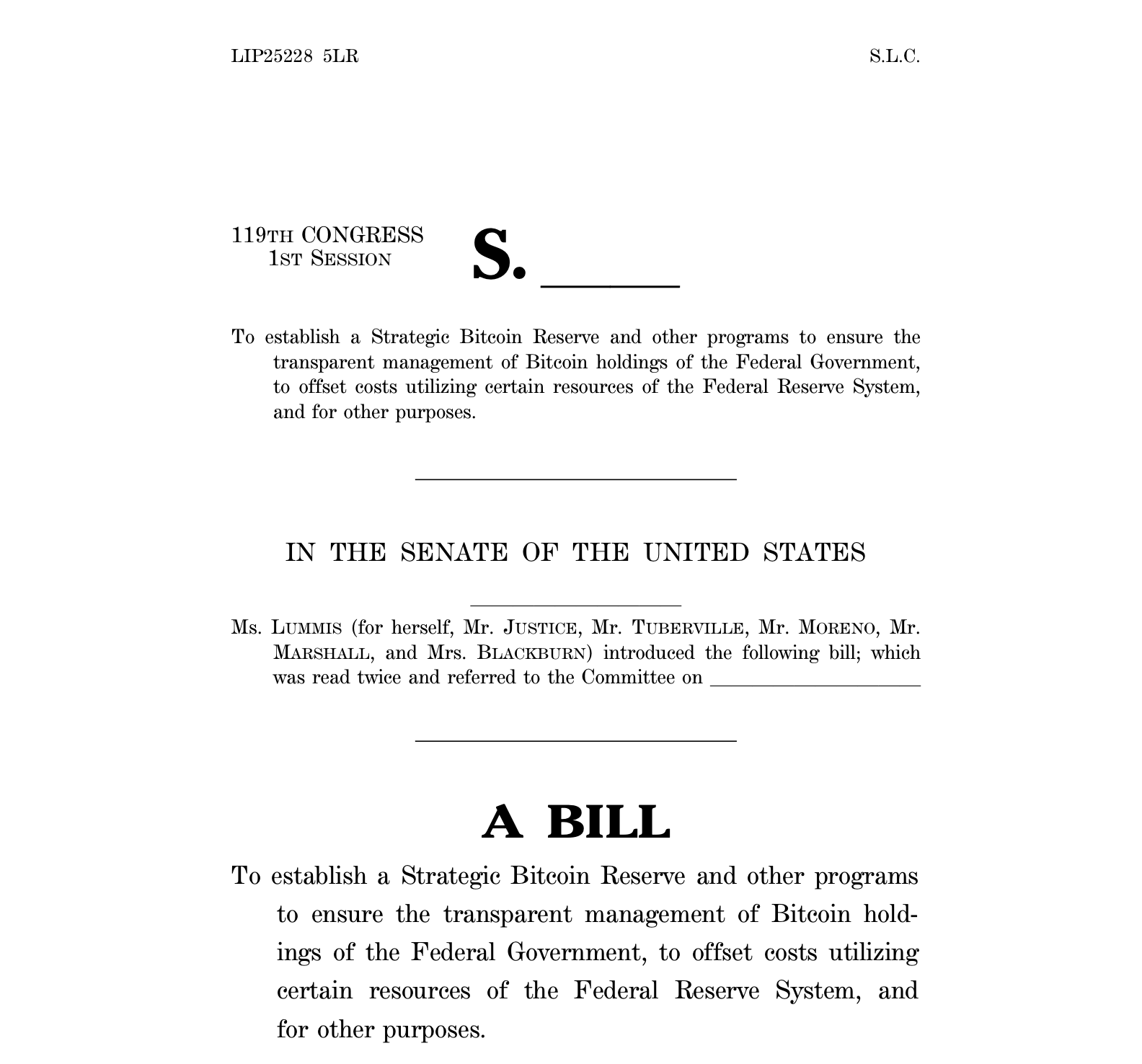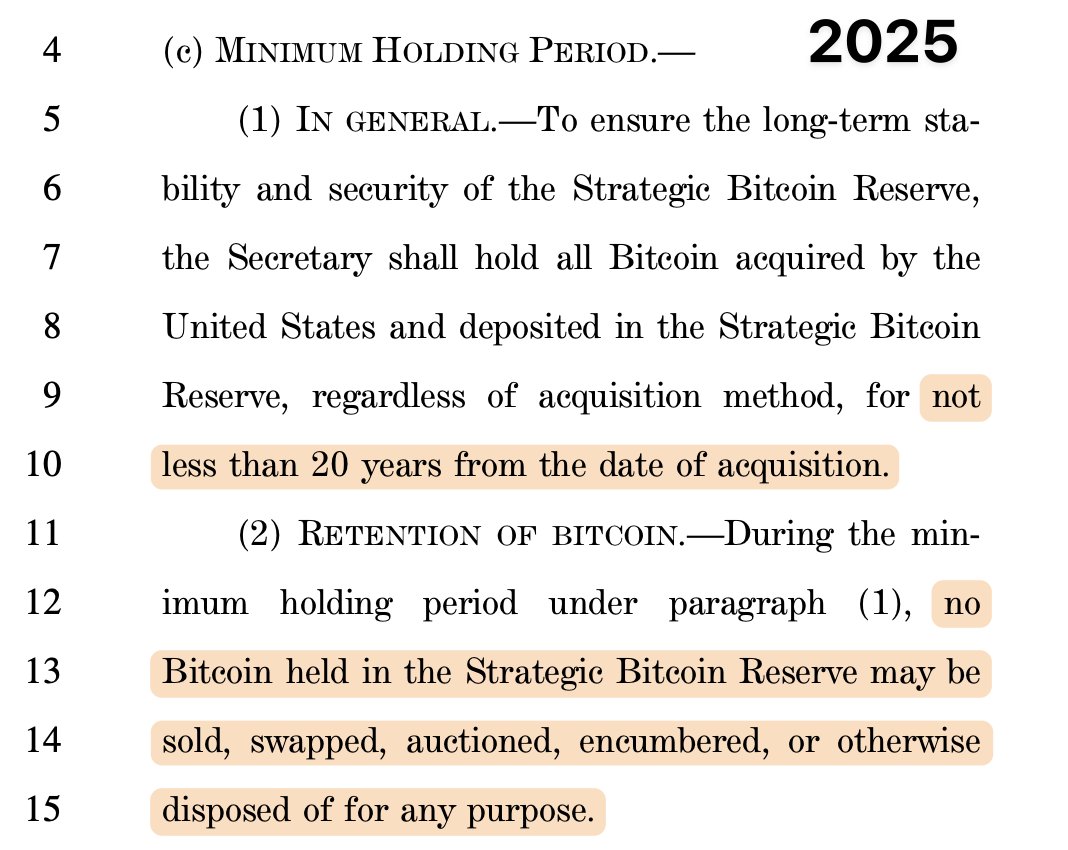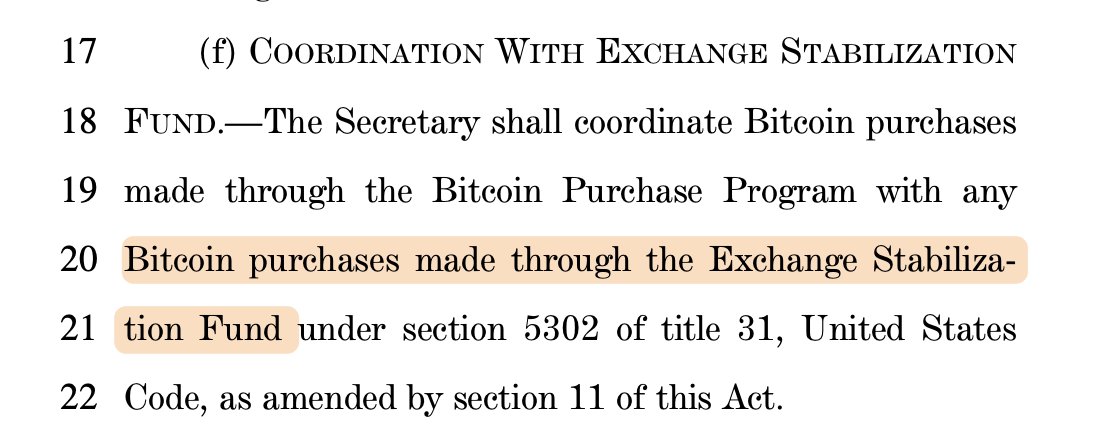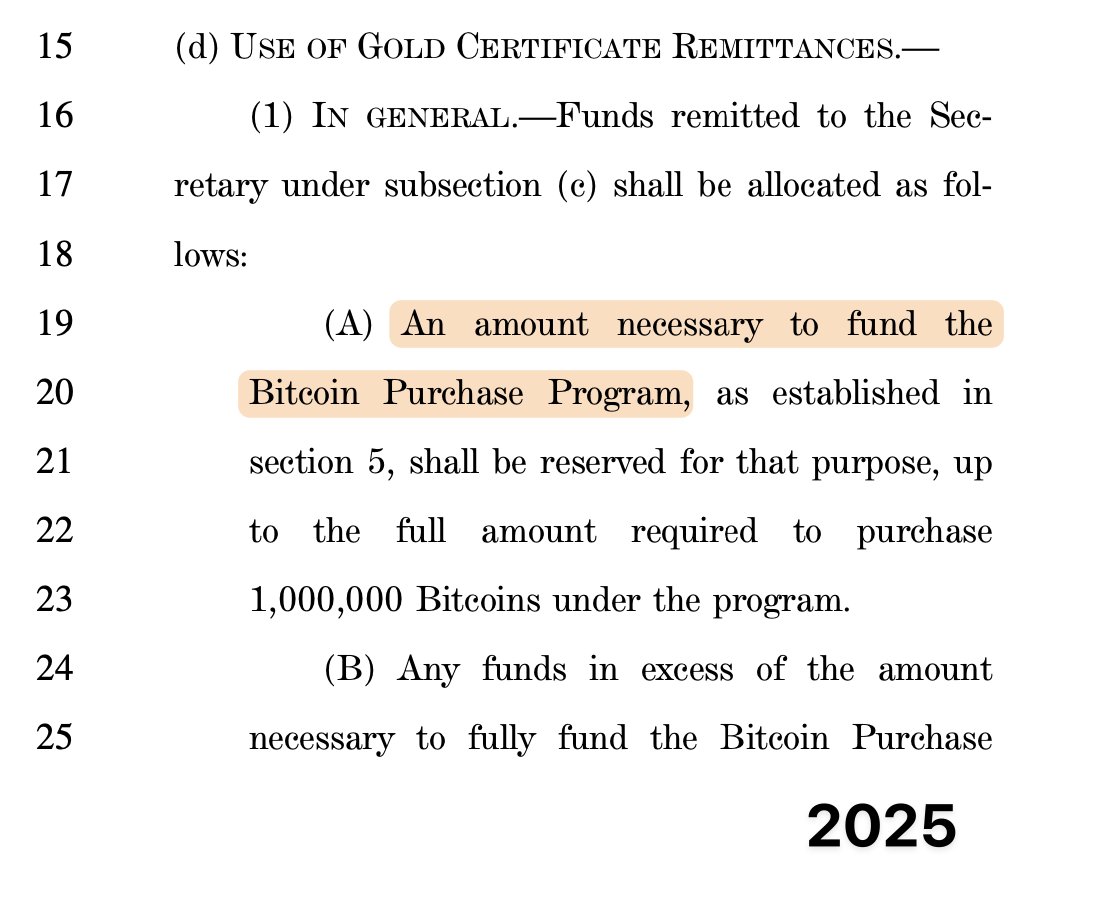Lummis' new version of Bitcoin bill interpretation: $747.3 billion in gold to buy Bitcoin

Reprinted from panewslab
03/14/2025·1MAuthor: Luke, Mars Finance
In March 2025, U.S. Senator Cynthia Lummis re-introduced the BITCOIN Act to the Senate in an attempt to build a strategic Bitcoin reserve through legislation. This move not only continued her original intention proposed in 2024, but also made key adjustments to the details, which triggered widespread discussion and heated market discussion. This article will provide an in-depth interpretation of the historical context of the bill, the content of the new version of the bill, and the profound impact of the purchase plan of 200,000 Bitcoins per year on the price of Bitcoin.

What are the changes in the new version of the bill history
Cynthia Loomis, a Republican senator from Wyoming, has been an active promoter in the field of Bitcoin policy since 2024. In July 2024, she first introduced the BITCOIN Act of 2024, aiming to build a Strategic Bitcoin Reserve similar to the strategic oil reserves through the government's purchase of Bitcoin. The goal of this proposal is to use Bitcoin as "digital gold" to enhance the United States' competitive advantage in the global financial system while providing new solutions to national debt. The bill proposes to purchase 1 million bitcoins (1,000,000 BTC) over five years, accounting for about 5% of the total Bitcoin supply at that time, and to achieve this by redirecting funds from the Federal Reserve system’s earnings and gold revaluation. However, the 2024 edition of the bill was blocked in the Congressional Committee and eventually "lapsed" at the end of the 2023-2024 annual session and failed to pass.
In March 2025, Loomis re-submitted the bill, launching the 2025 version of the Bitcoin Act. The new version retains its core goal – purchasing 1 million bitcoins in five years – but has several key changes in the details. The changes are intended to respond to previous criticisms, strengthen execution, and echo President Trump’s executive order to establish a strategic Bitcoin reserve signed in March 2025. Here are the main changes to the new version:
- Stricter Purchase Plan: The 2024 edition allows for "up to" purchase of 200,000 Bitcoins per year ("up to 200,000 Bitcoins per year"), while the 2025 edition clearly requires "must" purchase of 200,000 Bitcoins per year ("shall purchase 200,000 Bitcoins per year"), with a total of 1 million in five years. This change from "flexible" to "forced", showing the legislators' determination to implement the strength.
- Strengthening Holding Requirements: The 2024 edition allows the sale of Bitcoin within the 20-year minimum holding period to repay federal debt instruments, but the 2025 edition removes this exception and prohibits the sale, exchange or disposal of Bitcoin for any purpose within 20 years. This reinforces the strategic intention of "long-term holding" (HODL).
- New coordination with the Exchange Stabilization Fund (ESF): The 2025 edition adds coordination clauses with the Exchange Stabilization Fund (ESF) to allow the use of this approximately $39 billion reserve fund to support Bitcoin purchases. This clause was not mentioned in the 2024 edition, reflecting the diversification of the funding sources in the new edition.
- Use of Gold Revaluation Earnings: The 2024 edition incorporates the proceeds from the Federal Reserve’s gold revaluation into the general fund, while the 2025 edition explicitly stipulates that these earnings (potentially up to $747.3 billion) will be specifically used for Bitcoin purchase programs. This is a major policy adjustment that highlights the importance attached to Bitcoin as a strategic asset.
These changes not only reflect Loomis’ support for Bitcoin policy, but also a strategic adjustment made in the context of the current high enthusiasm of American politics for Bitcoin (such as Trump’s support and positive response from the community).
Detailed interpretation of the new version of the bill
In order to understand the revisions to the 2025 version of the Bitcoin Act, we analyze these key changes one by one and the logic and impact behind them.
Stricter purchase plan: from "maximum" to "must"
The 2024 version of the Bitcoin Purchase Plan is set to "up to" 200,000 Bitcoins per year, which provides the Ministry of Finance with flexibility to adjust purchases based on market conditions. However, this flexibility can also lead to poor execution or delays. The 2025 edition changes this clause to "must" purchase of 200,000 Bitcoins, a total of 1 million in five years. This change shows that lawmakers want to pass mandatory legal requirements to ensure that the government implements the establishment of Bitcoin reserves as planned.

This modification is intended to avoid delays and market uncertainty and ensure the rapid realization of strategic Bitcoin reserves. 200,000 Bitcoins each year account for about 1.04% of the current total Bitcoin supply (about 19.2 million), and the total volume of 1 million coins accounts for 5.19%. This scale matches the U.S. gold reserves (about 8,133.5 tons, accounting for nearly a quarter of the global gold reserves), reflecting the strategic intention of positioning Bitcoin as "digital gold." However, mandatory purchases can put pressure on market liquidity and require transparent and strategic means such as batch purchases or over-the-counter trading to reduce disturbances.
Strengthening holding requirements: Remove debt repayment exceptions
The 2024 edition allows Bitcoin to be sold within a 20-year minimum holding period to pay off federal debt instruments, an exception that provides flexibility for the government but also weakens the commitment to long-term holdings of Bitcoin as a strategic asset. The 2025 edition deletes this clause, which clearly stipulates that Bitcoin may not be sold, exchanged, auctioned or disposed of for any purpose within 20 years.

This change strengthens Bitcoin’s positioning as a “long-term store of value” and is consistent with the concept of “digital gold”. The 20-year holding period is designed to ensure the long-term appreciation potential of Bitcoin and provide stable strategic assets for the U.S. economy. However, this strict requirement may be controversial because it limits the possibility of governments using Bitcoin flexibly in economic crises, such as for repaying state debt or responding to emergencies.
New coordination with Exchange Rate Stability Fund (ESF)
The 2025 edition adds a coordination clause with the Forex Stability Fund (ESF), allowing the use of this reserve fund (about $39 billion) to support Bitcoin purchases. ESF is an emergency reserve fund used by the Ministry of Finance to stabilize exchange rates and financial markets, usually used to intervene in the foreign exchange market or support international financial stability.
This modification expands the source of funds and provides additional financial support for Bitcoin purchases. The entry of ESF indicates that the government plans to view Bitcoin as part of the national financial strategy, which may directly purchase Bitcoin through executive orders or market operations. However, this move may spark controversy over the use of ESF, as its original intention is not to be used for cryptocurrency investment, but to deal with the financial crisis.

Adjustment of the use of gold revaluation income
The "revaluation" of the Federal Reserve Gold refers to the reevaluation of the Treasury reserves held by the Treasury Department (approximately 8,133.5 tons) from the statutory price ($42.2222/oz) to the current market price (approximately $2,900/oz in March 2025). This revaluation will generate approximately $747.3 billion in book revenue (market value of approximately $758.3 billion minus book value of $11 billion).

The 2024 edition incorporates these earnings into general funds, while the 2025 edition explicitly uses them for Bitcoin purchase plans. This adjustment reflects firm support for Bitcoin’s strategic reserves and also provides a strong financial foundation for the bill’s “budget neutrality”. However, gold price fluctuations (possibly rising to $3,500/oz or falling to $2,500/oz) may affect the final available amount and require further legislation to be refined.
Strictly speaking, the bill does not require direct "selling" (selling) gold reserves. Gold will remain in the Ministry of Finance’s reserves and continue to be held as state assets. Revaluation is just an accounting adjustment, recapitulating the market value of gold into the balance sheet of the Ministry of Finance and using the added value for Bitcoin purchases.
However, from the economic perspective, this process is similar to the “indirect sale of the value of gold” to buy Bitcoin, because the book value of gold is converted into cash or equivalents for transactions in Bitcoin markets. These changes together reflect the comprehensive upgrade of the implementation, strategic positioning and financial guarantee of the 2025 edition of the Bitcoin Act, and lay a solid foundation for establishing strategic Bitcoin reserves.
Where will the 200,000 yuan be bought every year push Bitcoin?
If the Bitcoin Act is passed, the US government's purchase of 200,000 Bitcoins per year will have a profound impact on the price of Bitcoin.
As of March 2025, the circulation supply of Bitcoin was approximately 19.2 million, with a price of US$83,000 per coin, with a total market value of US$1.6 trillion. The daily transaction volume of Bitcoin is usually between $20 billion and $50 billion (assuming $35 billion), while the purchase amount of 200,000 Bitcoins per year is 200,000 × 83,000 = $1.66 billion, totaling $8.3 billion in five years. This accounts for 1.04% (annual) or 5.19% (five years) of total market value, which is relatively small, but continuous purchases may trigger a chain reaction in the market.
Dynamic analysis of supply and demand
- Increased demand: 200,000 bitcoins account for about 1.04% of the total supply per year, and if the market liquidity is limited, this demand may quickly push up prices. Bitcoin’s supply growth is limited by a four-year halving mechanism (currently outputs 6.25 BTC every 10 minutes), and most Bitcoins are long-term (HODLers) and have low liquidity.
- Market reaction: Historical data (such as Japan legalized Bitcoin in 2017 or adopted by institutions in 2020-2021) show that favorable policy and large-scale buying may cause prices to rise by 10%-50% in the short term, or even more. The synergies of mandatory purchases in the 2025 edition of the bill and the Trump executive order may trigger a "Fear Missing" (FOMO) effect, further pushing up prices.
Price forecast
Based on the supply and demand model and market sentiment, we can infer the following scenarios:
- Short term (1-3 months): If the market responds strongly to the passage of the bill, the price may rise by 10%-33%, reaching US$91,300-110,000 per coin. Around $45.48 million in buying ($1.66 billion/365 days) per day accounted for 0.013% of daily trading volume, but centralized purchases could push up the high price (above $80,000) with shallower depth of order book, resulting in a price break of $100,000.
- Medium term (1-2 years): As government continues to buy and market confidence increases, prices may reach USD 120,000-150,000 per coin (45%-81% up). If institutions and retail investors follow up, prices may soar further.
- Long-term (5 years): Purchase of 1 million bitcoins in five years (5.19% of the supply), coupled with reduced supply and macroeconomic factors (such as inflation or the depreciation of the US dollar), the price may exceed $200,000 per coin, especially during a bull cycle.
Final Outlook
After the passage of the Bitcoin Act, the US government's annual buying of 200,000 Bitcoins is likely to push the Bitcoin price to a new high, which may exceed US$110,000/com in the short term, reach US$150,000/com in the medium term, and may reach US$200,000/com in the long term. However, actual prices are highly dependent on market responses, buying strategies and external economic environment. This move may not only reshape Bitcoin’s global position, but also have a profound impact on the U.S. leadership in the digital currency field.
